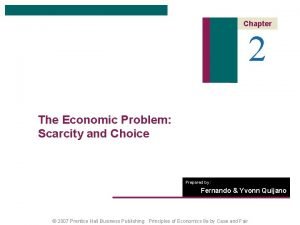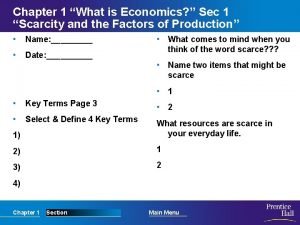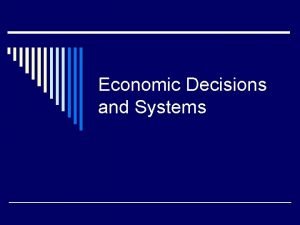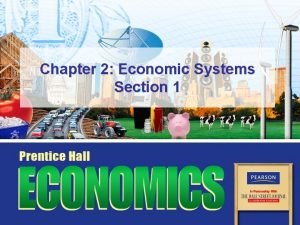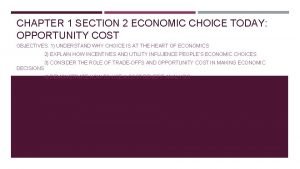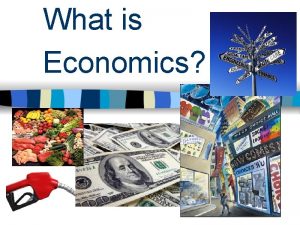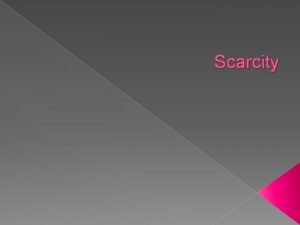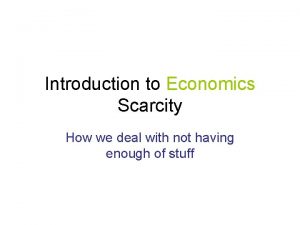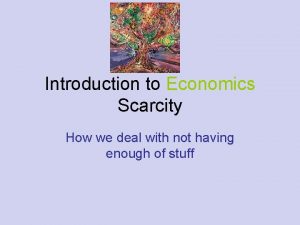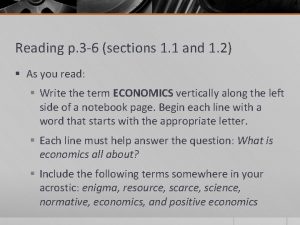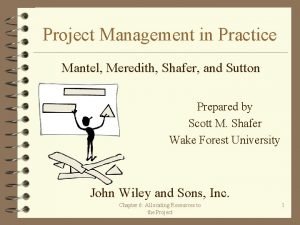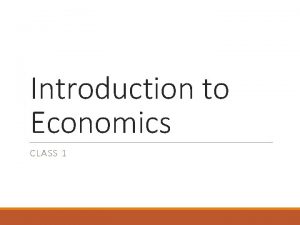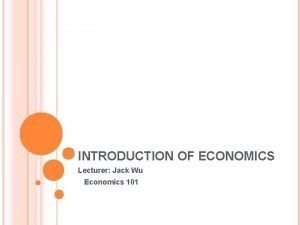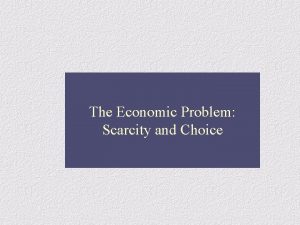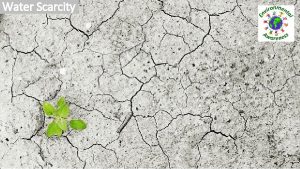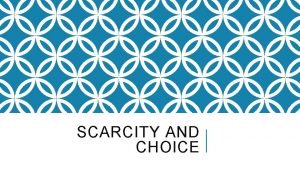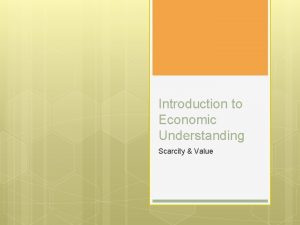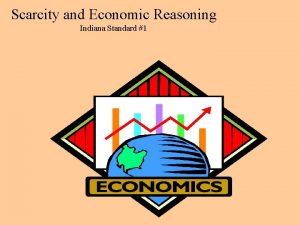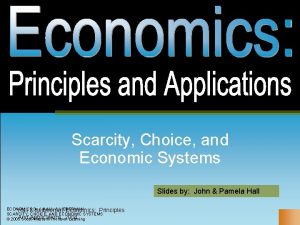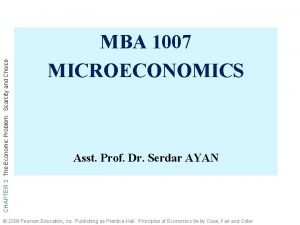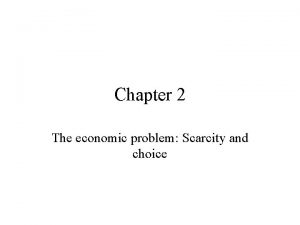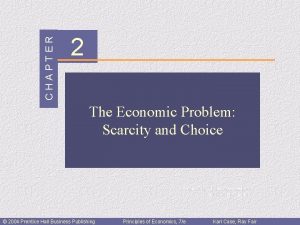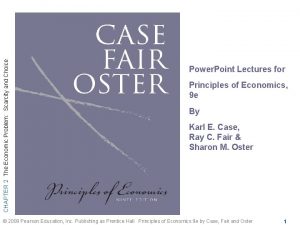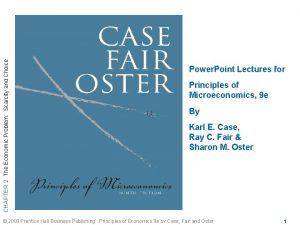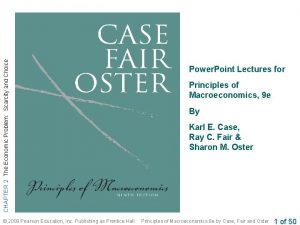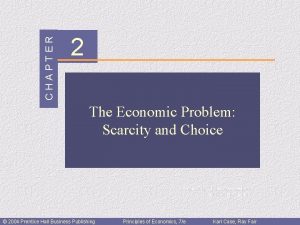Chapter 2 Scarcity Choice and Economic Systems INTRODUCTION




























- Slides: 28

Chapter 2 Scarcity, Choice, and Economic Systems INTRODUCTION TO ECONOMICS 2 e / LIEBERMAN & HALL CHAPTER 2 / SCARCITY, CHOICE, AND ECONOMIC SYSTEMS © 2005, South-Western/Thomson Learning Slides by John F. Hall Animations by Anthony Zambelli

The Concept of Opportunity Cost n Opportunity cost of any choice § What we forego when we make that choice n n n Most accurate and complete concept of cost Direct money cost of a choice may only be a part of opportunity cost of that choice Opportunity cost of a choice includes both explicit costs and implicit costs § Explicit cost—dollars actually paid out for a choice § Implicit cost—value of something sacrificed when no direct payment is made Lieberman & Hall; Introduction to Economics, 2005 2

Opportunity Cost and Society n All production carries an opportunity cost § To produce more of one thing • Must shift resources away from producing something else n The Principle of Opportunity Cost § The concept of opportunity cost sheds light on virtually every problem that economists study, whether it be explaining the behavior of consumers or business firms or understanding important social problems like poverty or racial discrimination n Basic Principle #2: Opportunity Cost § All economic decisions made by individuals or society are § costly The correct way to measure the cost of a choice is its opportunity cost—that which is given up to make the choice Lieberman & Hall; Introduction to Economics, 2005 3

Production Possibilities Frontiers (PPF) Curve showing all combinations of two goods that can be produced with resources and technology available n Society’s choices are limited to points on or inside the PPF n Lieberman & Hall; Introduction to Economics, 2005 4

Figure 1: The Production Possibilities Frontier Quantity of All Other Goods per Period 1, 000 950, 000 850, 000 A At point A, all resources are used for "other goods. " B C 700, 000 500, 000 400, 000 W Moving from point A to point B requires shifting resources out of other goods and into health care. D E At point F. all resources are used for health care. F 100, 000 200, 000 300, 000 400, 000 500, 000 Number of Lives Saved per Period Lieberman & Hall; Introduction to Economics, 2005 5

Increasing Opportunity Cost n According to law of increasing opportunity cost § The more of something we produce • The greater the opportunity cost of producing even more of it n This principle applies to all of society’s production choices Lieberman & Hall; Introduction to Economics, 2005 6

The Search for a Free Lunch n Productive Inefficiency § More of at least one good can be produced • Without pulling resources from the production of any other good n No industry, firm or economy is ever 100% productively efficient § However, cases of gross inefficiency are not as common as you might think Lieberman & Hall; Introduction to Economics, 2005 7

Recessions n A slowdown in overall economic activity when resources are idle § Widespread unemployment § Factories shut down n • Land capital are not being used An end to the recession would move the economy from a point inside its PPF to a point on its PPF § Using idle resources to produce more goods and services without sacrificing anything • Can help us understand an otherwise confusing episode in U. S. economic history Lieberman & Hall; Introduction to Economics, 2005 8

Recessions n During early 1940 s, standard of living in U. S. did not decline as we might have expected but actually improved slightly. Why? § U. S. entered World War II and began using massive amounts of resources to produce military goods and services • Instead of pitting “health care” against “all other goods, ” we look at • • society’s choice between military goods and civilian goods U. S. was still suffering from the Great Depression when it entered WWII Joining war effort helped end the Depression and moved economy from a point like A, inside the PPF, to a point like B, on the frontier ¨ ¨ Military production increased, but so did the production of civilian goods Although there were shortages of some consumer goods § Overall result was a rise in the material well-being of the average U. S. citizen War is only one factor that can reverse a downturn No rational nation would ever choose war as an economic policy designed to cure a recession § Alternative policies that virtually everyone would find preferable Lieberman & Hall; Introduction to Economics, 2005 9

Figure 2: Production and Unemployment Military Goods per Period 1. Before WWII the United States operated inside its PPF. . . B 2. then moved to the PPF during the war. Both military and civilian production increased. A Civilian Goods per Period Lieberman & Hall; Introduction to Economics, 2005 10

Economic Growth n n n If economy is already operating on its PPF § Cannot exploit opportunity to have more of everything by moving to it But what if the PPF itself were to change? Couldn’t we then produce more of everything? § This happens when an economy’s productive capacity grows Many factors contribute to economic growth, but they can be divided into two categories § Quantities of available resources—especially capital—can increase • An increase in physical capital enables economy to produce more of everything that uses these tools ¨ More factories, office buildings, tractors, or high-tech medical equipment ¨ Skills of doctors, engineers, construction workers, software writers, etc. • Same is true for an increase in human capital § Technological change enables us to produce more from a given quantity of resources Lieberman & Hall; Introduction to Economics, 2005 11

Economic Growth n n n Increases in capital and technological change often go hand in hand For instance, PET body scanners will enable us to save even more lives than our current set of resources § Moving horizontal intercept of PPF rightward, from F to F‘ § Impact of PET scanners stretches PPF outward along horizontal axis How can a technological change in lifesaving enable us to produce more goods in other areas of the economy? § Society can choose to use some of increased lifesaving potential to shift other resources out of medical care and into production of other things • Because of technological advance and new capital, we can shift resources without sacrificing lives Lieberman & Hall; Introduction to Economics, 2005 12

Economic Growth n If we can produce more of the things that we value, without having to produce less of anything else, have we escaped from paying an opportunity cost? § Yes. . . and no § Figure 3 tells only part of story • Leaves out steps needed to create this shift in the PPF • For example, technological innovation doesn’t just “happen”— resources must be used to create it ¨ n Mostly by research and development (R&D) departments of large corporations In order to produce more goods and services in the future, we must shift resources toward R&D and capital production § Away from production of things we’d enjoy right now Lieberman & Hall; Introduction to Economics, 2005 13

Figure 3: The Effect of a New Medical Technology Quantity of All Other Goods per Period 1, 000 2. But not its vertical intercept. 4. or more lives saved and greater production of other goods. A J 700, 000 H D 1. A technological advance in saving lives increases this PPF's horizontal intercept. . . 300, 000 3. The economy can end up with more lives saved and unchanged production of other goods. . . F F' 500, 000 600, 000 Number of Lives Saved per Period Lieberman & Hall; Introduction to Economics, 2005 14

Specialization and Exchange n Specialization § Method of production in which each person concentrates on a limited number of activities n n n Exchange § Practice of trading with others to obtain what we want Allows for § Greater production § Higher living standards than otherwise possible All economics exhibit high degrees of specialization and exchange Lieberman & Hall; Introduction to Economics, 2005 15

Further Gains to Specialization n Absolute Advantage: A Detour § Ability to produce a good or service using fewer resources than other producers use n Comparative Advantage § If one can produce some good with a smaller opportunity § § cost than others can Total production of every good or service will be greatest when individuals specialize according to their comparative advantage Another reason why specialization and exchange lead to higher living standards than self-sufficiency Lieberman & Hall; Introduction to Economics, 2005 16

Specialization in Perspective n While specialization gives us material gains § There may be opportunity costs to be paid in the loss of other things we care about n The right amount of specialization can be found by balancing gains against costs Lieberman & Hall; Introduction to Economics, 2005 17

Resource Allocation n Problem of resource allocation § Which goods and services should be produced § § with society’s resources? • Where on the PPF should economy operate? How should they be produced? • No capital at all • Small amount of capital • More capital Who should get them? • How do we distribute these products among the different groups and individuals in our society? Lieberman & Hall; Introduction to Economics, 2005 18

The Three Methods of Resources Allocation n Traditional Economy § Resources are allocated according to long-lived practices from the past n Command Economy (Centrally-Planned) § Resources are allocated according to explicit instructions from a central authority n Market Economy § Resources are allocated through individual decision making Lieberman & Hall; Introduction to Economics, 2005 19

The Nature of Markets n. A market is a group of buyers and sellers with the potential to trade with each other § Global markets • Buyers and sellers spread across the globe § Local markets • Buyers and sellers within a narrowly defined area Lieberman & Hall; Introduction to Economics, 2005 20

The Importance of Prices A price is the amount of money that must be paid to a seller to obtain a good or service n When people pay for resources allocated by the market n § They must consider opportunity cost to society of their individual actions n Markets can create a sensible allocation of resources Lieberman & Hall; Introduction to Economics, 2005 21

Resource Allocation in the United States n n Numerous cases of resource allocation outside the market § Such as families Various levels of government collect about one-third of our incomes as taxes § Enables government to allocate resources by command Government uses regulations of various types to impose constraints on our individual choice The market is the dominant method of resource allocation in United States § However, it is not a pure market Lieberman & Hall; Introduction to Economics, 2005 22

Resource Ownership n Communism § Most resources are owned in common n Socialism § Most resources are owned by state n Capitalism § Most resources are owned privately Lieberman & Hall; Introduction to Economics, 2005 23

Types of Economic Systems n An economic system is composed of two features § Mechanism for allocating resources • Market • Command § Mode of resource ownership • Private • State Lieberman & Hall; Introduction to Economics, 2005 24

Figure 4: Types of Economic Systems Resource Allocation Private Market Command Market Capitalism Centrally Planned Capitalism Market Socialism Centrally Planned Socialism Resource Ownership State Lieberman & Hall; Introduction to Economics, 2005 25

Economic Systems and This Book This book will focus on market capitalist economies n About 400 million people have come under the sway of the market in past decade n More are being added as China changes to a market economy n Study of modern economies is study of market capitalism n Lieberman & Hall; Introduction to Economics, 2005 26

Using Theory: Are We Saving Lives Efficiently? n n n Could be productive inefficiency in saving human lives Some economists have argued that we waste significant amounts of resources in our lifesaving efforts § How have they come to such a conclusion? Saving a life—no matter how it is done—requires use of resources § Any lifesaving action we might take requires certain quantities of resources • For example, putting another hundred police on the streets, building another emergency surgery center, or running an advertising campaign to encourage healthy living § In a market economy, resources sell at a price • Allows us to use the dollar cost of a lifesaving method to measure value • of resources used up by that method Can compare “cost per year of life saved” of different methods Lieberman & Hall; Introduction to Economics, 2005 27

Using Theory: Are We Saving Lives Efficiently? n Cost per life saved of various life-saving methods ranges widely § From $150 per year of life saved for a physician warning a patient to quit smoking, to over $66, 000 per year of life saved from the ban on asbestos in automatic transmissions n n Some lifesaving methods are highly cost effective but some serious productive inefficiency exists in lifesaving Allocating lifesaving resources is much more complicated than our discussion so far has implied § Benefits of lifesaving efforts are not fully captured by “life-years saved” • Or even by an alternative measure, which accounts for improvement in quality of life n Another difficulty in allocating our lifesaving resources efficiently is uncertainty § Trying to gauge and improve our productive efficiency in saving lives—which was never an exact science—has become even less exact in the post-9/11 era Lieberman & Hall; Introduction to Economics, 2005 28
 Explain scarcity and choice
Explain scarcity and choice Scarcity, choice and opportunity cost example
Scarcity, choice and opportunity cost example The basic economic problem results from scarcity.
The basic economic problem results from scarcity. Economics unit 1 lesson 2 difficult choices
Economics unit 1 lesson 2 difficult choices Chapter 1 section 1 scarcity
Chapter 1 section 1 scarcity Chapter 2 economic systems and decision making answer key
Chapter 2 economic systems and decision making answer key Chapter 2 economic systems and decision making
Chapter 2 economic systems and decision making Chapter 2 economic systems and decision making
Chapter 2 economic systems and decision making Chapter 1 economic decisions and systems answer key
Chapter 1 economic decisions and systems answer key Comparative systems worksheet answer key
Comparative systems worksheet answer key Good choice or bad choice
Good choice or bad choice Prof. meier and baldwin
Prof. meier and baldwin Chapter 2 economic systems answer key
Chapter 2 economic systems answer key What is economics
What is economics Concept of opportunity cost
Concept of opportunity cost Economic choice today opportunity cost
Economic choice today opportunity cost Economic growth vs economic development
Economic growth vs economic development People with all their efforts, abilities, and skills
People with all their efforts, abilities, and skills Scarcity lesson plan
Scarcity lesson plan Opportunity costs def
Opportunity costs def Causes of scarcity
Causes of scarcity Er ir ur sentences
Er ir ur sentences Scarcity forces tradeoffs symbol
Scarcity forces tradeoffs symbol Scarcity entrepreneurship definition
Scarcity entrepreneurship definition Scarcity
Scarcity Resources scarcity
Resources scarcity Resources scarcity
Resources scarcity Resources scarcity
Resources scarcity Resources scarcity
Resources scarcity
